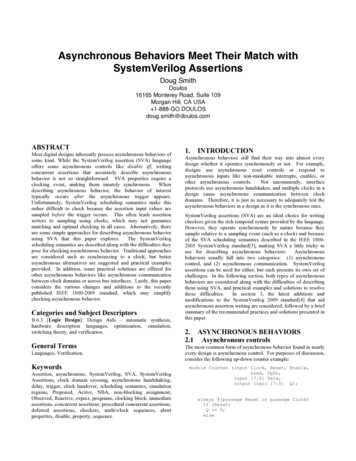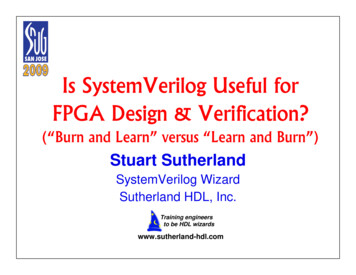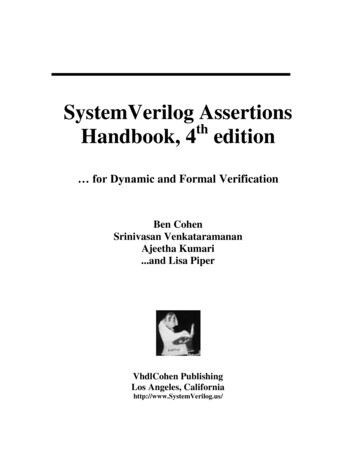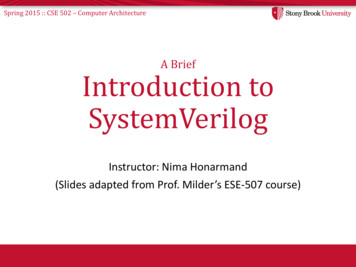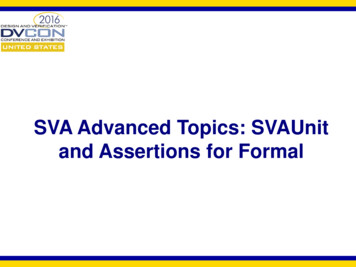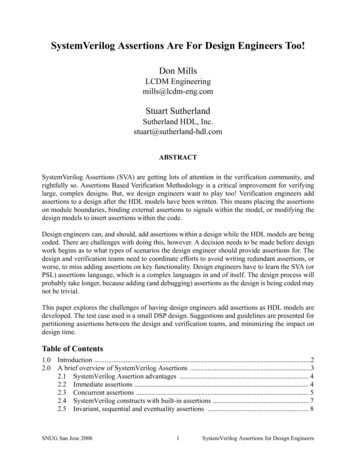
Transcription
SystemVerilog Assertions Are For Design Engineers Too!Don MillsLCDM Engineeringmills@lcdm-eng.comStuart SutherlandSutherland HDL, Inc.stuart@sutherland-hdl.comABSTRACTSystemVerilog Assertions (SVA) are getting lots of attention in the verification community, andrightfully so. Assertions Based Verification Methodology is a critical improvement for verifyinglarge, complex designs. But, we design engineers want to play too! Verification engineers addassertions to a design after the HDL models have been written. This means placing the assertionson module boundaries, binding external assertions to signals within the model, or modifying thedesign models to insert assertions within the code.Design engineers can, and should, add assertions within a design while the HDL models are beingcoded. There are challenges with doing this, however. A decision needs to be made before designwork begins as to what types of scenarios the design engineer should provide assertions for. Thedesign and verification teams need to coordinate efforts to avoid writing redundant assertions, orworse, to miss adding assertions on key functionality. Design engineers have to learn the SVA (orPSL) assertions language, which is a complex languages in and of itself. The design process willprobably take longer, because adding (and debugging) assertions as the design is being coded maynot be trivial.This paper explores the challenges of having design engineers add assertions as HDL models aredeveloped. The test case used is a small DSP design. Suggestions and guidelines are presented forpartitioning assertions between the design and verification teams, and minimizing the impact ondesign time.Table of Contents1.0 Introduction .22.0 A brief overview of SystemVerilog Assertions .32.1 SystemVerilog Assertion advantages . 42.2 Immediate assertions . 42.3 Concurrent assertions . 52.4 SystemVerilog constructs with built-in assertions . 72.5 Invariant, sequential and eventuality assertions . 8SNUG San Jose 20061SystemVerilog Assertions for Design Engineers
3.04.05.06.07.08.09.0Where assertions can be specified .9An assertions test plan for a small DSP design .104.1 The DSP design blocks . 104.2 An assertions plan for the DSP . 114.3 Rule of thumb for delegating assertions . 124.4 An example assertions test plan . 12Example assertions per the assertion test plan .165.1 ALU block: No X on inputs; All opcodes decoded . 165.2 RAM: Mutually exclusive read/write control lines . 175.3 Controller state machine: At posedge of clock, state is always one-hot . 175.4 Controller state machine: Proper state sequencing . 17Lessons learned .186.1 Developing the assertions test plan takes time . 186.2 The assertion test plan helps identify similar assertions . 186.3 Take advantage of SystemVerilog constructs with built-in assertions . 196.4 An assertion should not just duplicate RTL functionality . 196.5 Disabling assertions during resets is important . 196.6 Need to be flexible on who writes the assertions . 196.7 Testing logic that has enumerated types requires access to the enumerated names . 206.8 Enumerated type labels disappear after synthesis . 206.9 Assertion based verification may require different design partitioning . 21Conclusions .21References .22About the authors .231.0 IntroductionDesign engineers have a number of objectives that must be met for each design. These objectivesinclude meeting area, timing, and power requirements. And of course, the design must alsorepresent the specification. There are a number of tools and techniques used by design andverification engineers to verify that a design correctly represents its specification. The focusdiscussed in this paper is to show design engineers how they can take advantage of SystemVerilogAssertions (SVA) as a tool to prove the intent of the design. This paper is written from a designengineer’s perspective, targeted toward design engineers that do not have a strong background inassertion techniques and usage.The application of assertions to a design involves a number of considerations, the first of which isdetermining which assertions will be written by design engineers and which will be written by theverification and/or system engineers. Many of the assertions to be used to verify a design can, andshould, be determined before the design implementation phase begins. During theimplementation, the designer may need to add assertions beyond what was initially planned,based on the design implementation. The designer may also need to make recommendations to theverification team for additional top level assertions based on the details of the implementation.There will be a learning curve for a designer who is new to assertions, but with the help of thispaper and other available resources, a designer can start implementing SystemVerilog Assertionsinto a design within a short period of time. As a beginning point, there are two mainSNUG San Jose 20062SystemVerilog Assertions for Design Engineers
considerations a designer must make when adding assertions. The first consideration is torecognize where to add assertions in a design. The second is to determine which type of assertionto add. This paper will address these two considerations from a designer’s perspective.A small 16-bit DSP is used as a case study for implementing SystemVerilog Assertions. This DSPis used as a student design lab for Sutherland HDL training courses, and is designed to be simpleenough that the students can complete the DSP design in four to six hours. The design is complexenough to require modeling of a variety of RTL blocks including a finite state machine (FSM), anarithmetic logic unit (ALU), various registers and counters, and a bidirectional bus. This DSP labserves a dual purpose. The DSP design is a final project for students learning to writesynthesizable Verilog/SystemVerilog models. A complete, but broken, version of the DSP designis used for students learning to write SystemVerilog assertions.The DSP design lab has been used for a number of years in Sutherland HDL training courses.Over the years the instructors have observed a number of common coding errors and specificationmisunderstandings. These errors include: Bus contention on the multi-driver, bidirectional data busMSB of the 16-bit data bus not tri-statedThe trailing edge of reset not properly synchronized with the clocksThe ALU exception and zero flags not properly cleared on the next operation after a flag is setWrong bits of the instruction word bus connected to the program counter and controllerRace conditions due to misuse of blocking and nonblocking assignmentsAssertions will provide feedback to the designer during simulation regarding these commonerrors, as well as many others potential coding discussed later in this paper.The conclusions of this paper will summarize the ease (or difficulty) of adding assertions to theDSP design, as well as several lessons learned from having students (both design engineers andverification engineers) specify SystemVerilog Assertions.2.0 A brief overview of SystemVerilog AssertionsSystemVerilog has two types of formal assertion statements: immediate assertions and concurrentassertions. Both immediate and concurrent assertions perform a test on an aspect of the design. Atthe completion of the test, pass or fail statements can be executed. In addition to the failstatements, the failure severity level can be set for each assertion. The severity levels are set bycalling system tasks which include: — run-time fatal error — run-time error warning — run-time warning info — notes that the assertion failed, but without any severity fatalEach of these severity level system tasks will print a tool-specific message, and may also includeuser comments using the same syntax as the Verilog display system task. Specifying a severitylevel is optional; the default for assertion failures is error, if not explicitly specified.SNUG San Jose 20063SystemVerilog Assertions for Design Engineers
2.1 SystemVerilog Assertion advantagesAssertion-like checks can be added into a design using the standard Verilog language. There are,however, some serious drawbacks to writing assertion checks this way. One disadvantage is thatcomplex assertion-like checks can require writing complex Verilog code. Another disadvantage isthat checks written in Verilog will appear to be part of the RTL model to a synthesis compiler. Athird disadvantage is that an assertion-like check written in the Verilog language will be activethroughout simulation; there is no simple way to disable some or all checks during simulation.One of the biggest advantages to using SystemVerilog assertions over embedding checks writtenusing Verilog statements in the design is that SystemVerilog assertions are ignored by synthesis.The designer does not need to include translate off/translate on synthesis pragmasscattered throughout the RTL code. The reality is that most designers simply do not embed“homemade” assertions written in Verilog into their designs because the extra code and synthesispragmas convolutes the RTL model. For instance, rarely is an if statement implemented asfollows in an RTL model:if (if condition)// do true statementselse//translate offif (!if condition)//translate on// do the not true statements//translate offelse display("if condition tested either an X or Z");//translate onA second advantage to using SystemVerilog assertions over “homemade” assertion-like checkswritten in Verilog is that SystemVerilog Assertions can easily be disabled or enabled at any pointduring simulation, as needed. This allows designers to add assertions to the RTL code, but thendisable the assertions for simulation speed later in the design process, or to focus assertion checksto a specific region of the design. Assertion can be controlled in several ways: All assertions in specific levels of hierarchy can be turned off and on. Assertions within a specific module can be disabled and enabled. Assertions can be individually disabled and enabled.The system tasks to perform these operations are assertoff, assertkill, and asserton.2.2 Immediate assertionsImmediate assertions, as the name implies, execute immediately, in zero simulation time.Immediate assertions can be placed anywhere procedural statements can be placed; within alwaysblocks, initial blocks, tasks, and functions. Any procedural statement can be used in the pass orfail statement part of an immediate assertion. Care must be taken to ensure that no designfunctionality is modeled in the pass/fail parts of an assertion, because it will be ignored bysynthesis, thus causing a modeling difference between simulation and synthesis.SNUG San Jose 20064SystemVerilog Assertions for Design Engineers
The syntax for an immediate assertion is:assert (expression) [pass statement;] [else fail statement;]Note that the pass statement is optional. Most engineers will not specify any pass statements;engineers are looking for failures, and don’t need to do anything when an assertion succeeds. Theelse fail statement is also optional. If it is left off, a tool-generated message will be printed, witha default severity level of error. Designers often specify an assertion fail condition in order toaugment the default assertion failure information provided by simulation.Below are two examples of immediate assertions to check for X or Z values in combinationallogic conditional expressions.module example 1 (inputifcond, a, b,output logic if out);always comb beginassert ( ifcond ! 1’bx);else error("ifcond X");if (ifcond)if out a;elseif out b;endendmodulemodule example 2 (inputa, b, c, d,input [1:0] sel,output logic out);always comb beginassert ( sel ! 1’bx);else error("case Sel X");case (sel)2'b00 : out a;2'b01 : out b;2'b10 : out c;2'b11 : out d;endcaseendendmoduleFor more examples and details on using immediate assertions to trap logic X and Z problems,refer to the paper “Being Assertive With Your X” [2], published in the proceedings of SNUG 2004.2.3 Concurrent assertionsConcurrent assertions use a clock to trigger the assertion evaluation. The primary differenceSNUG San Jose 20065SystemVerilog Assertions for Design Engineers
between immediate and concurrent assertions is that concurrent assertions evaluate conditionsover time, whereas immediate assertions test at the point in time when the assertion is called. Thesyntax difference between the two types of assertions is very slight. The concurrent assertiondirective adds the key word property. The syntax for a concurrent assertion directive is:assert property (property expr) [pass statement;] [else fail statement;]The argument to assert property is a property expression (whereas, the argument to animmediate assertion is a simple boolean expression). A property expression comprises of a clockspecification and a sequence of Boolean expressions tested over time. The expressions areevaluated on the clock edge specified. The sequence of Boolean expressions can be spread overmultiple clock cycles by using the ## cycle delay operator between each expression.The following code is an example of a completely self contained concurrent assertion directive.example 3:assert property @(posedge clk) ( req ##1 grant ##10!req ##1 !grant);else error("bus request failed");In English, the sequence in the example above is read as: “req should be true (high) immediately,followed by grant being true (high) one clock cycle later. After ten more clock cycles, req shouldbe false (low), followed by grant being false (low) one clock cycle later.” For this assertion tosucceed, each expression must evaluate true at its specified time.The property expression of a concurrent assertion can be defined in a separate block of code,between the keywords property and endproperty. This enables the same property expression tobe re-used by multiple concurrent assertions.property bus req prop2;@(posedge clk) req ##1 grant ##10 !req ##1 !grant;endpropertyexample 4:assert property (bus req prop2};else error("bus request failed");A complex property expression can be broken into smaller sequence building blocks, specifiedbetween sequence and endsequence. This is illustrated in the following example.sequence start bus req;req ##1 grant;endsequencesequence end bus req;!req ##1 !grant;endsequenceproperty bus req prop3;@(posedge clk) start bus req ##10 end bus req;endpropertyexample 5: assert property (bus req prop3};Most concurrent assertions are written so that the assertion “fires” each and every clock cycle,SNUG San Jose 20066SystemVerilog Assertions for Design Engineers
throughout simulation. This allows the assertion to run in the background, concurrent with thedesign functionality. Since the assertion fires every clock cycle, an assertion with a sequence thattakes twelve clock cycles to execute could possibly have twelve concurrent threads running at thesame time; each thread starting on a subsequent clock cycle. In the bus request/grant sequenceexamples above, req will be tested every clock cycle, starting a new concurrent assertion thread.If req is true, the thread will continue and test for grant on the next clock cycle. If req is false,however, the assertion will fail at that point in time. This would be a false failure, since there is nodesign problem.Property expressions can be specified with an implication operator, either - or (there is animportant difference in these two operators, but we won’t go into that level of detail in thispaper—our examples will just use the - implication operator, which is the style we recommendin our training courses). An implication operator tells the property not to evaluate a sequence (theconsequent) unless the first condition before the operator (the antecedent) is true. In the codeexamples above, the designer will most likely only want to test the request/grant sequence whenreq is true. For clock cycles where req is false, the assertion is a don’t care, and the request/grantsequence should not be evaluated. In the following example, the implication operator prevents thesequence from continuing when req is not true. The assertion does not fail, it simply does not run.property bus req prop4;@(posedge clk) req - ##1 grant ##10 !req ##1 !grant;endpropertyexample 6:assert property (bus req prop4);A property expression can automatically be disabled under specific conditions using a disablestatement. When the condition specified with disable iff is false, the assertion does notfire, and kills any threads that are already running. A primary usage of disable iff is to preventfalse assertion failures from occurring while a design is being reset. The next example illustratesthis usage.iffproperty bus req prop5;@(posedge clk)disable iff (reset) // disable assertion during resetreq - ##1 grant ##10 !req ##1 !grant;endpropertyexample 5:assert property (bus req prop5);In addition to disable iff and the implication operator, there are several other propertyoperators that are useful in defining properties. These other operators are not covered in thispaper.2.4 SystemVerilog constructs with built-in assertionsIn addition to the assert construct, SystemVerilog provides some important RTL modelingconstructs that have built-in assertion behavior. Three primary constructs are briefly covered inthis section. By using these constructs, design engineers gain the advantages of adding assertionsto a design, without having to actually write the assertions.SNUG San Jose 20067SystemVerilog Assertions for Design Engineers
always comb — This specialized procedural block provides several capabilities that the Verilogalways procedural block does not have. In brief, this specialized block enforces a synthesizablemodeling style. In addition, the always comb block allows software tools to check that the codewithin the block functions as combinational logic. For example, there are a number of codingmistakes in intended combinational logic that can result in latches. By using always comb, thesecoding mistakes can be detected early in the design stage. Writing assertions to detect inadvertentlatched behavior is not necessary; the checks are built into the always comb construct. Moredetails on always comb and other SystemVerilog specialized procedural blocks (always ff andalways latch) can be found the book “SystemVerilog for Design” [3].Note that the IEEE SystemVerilog standard does not require a tool to detect and report latchedlogic functionality in an always comb procedural block. At the time this paper was written, VCSdoes not report such warnings, but DC Compiler does.unique/prioritysequence (a casedecisions — These decision modifiers require that tools check that a decisionstatement or an if.else.if statement) be completely specified. If duringsimulation, the decision statement is entered and no branch is taken, a run-time warning is issued.This is a useful built-in assertion that does not need to be written as a separate assert statement. Inaddition, the unique modifier requires that simulation report a warning any time two or moredecision branches are true at the same time. This is another built-in assertion that designers shouldtake advantage of. For a much more detailed description on unique and priority decisions, refer tothe papers “SystemVerilog Saves the Day—the Evil Twins are Defeated! “unique” and “priority”are the new Heroes” [4], and “SystemVerilog’s priority & unique - A Solution to Verilog’s‘full case’ & ‘parallel case’ Evil Twins!”[5].Enumerated types — Enumerated types provide a mechanism to give names (called labels) tospecific logic values. Enumerated types do much more than make code more readable. They alsospecify a legal set of values for a variable. Enumerated variables are more strongly typed thanVerilog variables. It is illegal to assign an enumerated variable a value that is not in theenumerated value set. In addition, it is illegal to have two enumerated labels with the same value.The strongly typed nature of enumerated types is a form of built-in assertions that can preventinadvertent coding errors such as assigning a state machine state variable the value of a nonexistent state, or having a state value that decodes to more than one state. More details on theadvantages of enumerated types can be found in the book “SystemVerilog for Design” [3].2.5 Invariant, sequential and eventuality assertionsLanguages such as C, SystemC and VHDL have an assertion construct. These constructs,however, do not have near the capabilities of SystemVerilog Assertions (neither does PSL, for thatmatter). The C, SystemC and VHDL assert construct is essentially the same as SVA’s immediateassertion. What makes SVA unique is the ability to specify concurrent assertions that evaluate as aseparate thread in parallel with the design code, and can span any number of design clock cycles.(PSL also has concurrent assertions, but lacks some features and advantages of SVA).SystemVerilog Assertions can be categorized into three general classifications.Invariant assertions look for conditions that are always true or are never true. For example, aFIFO should never indicate full and empty conditions at the same time. An invariant assertion canSNUG San Jose 20068SystemVerilog Assertions for Design Engineers
be represented using either an immediate assertion or a concurrent assertion. Most of theassertions that are specified by design engineers will probably be invariant assertions.Sequential assertions look for a set of conditions occurring in a specific order and over a specificnumber of clock cycles. The examples shown in section 2.3, above, are sequential assertions,where req should be followed by grant followed by !req followed by !grant.Eventuality assertions check that one condition is followed by a second condition, but with anynumber of clocks between the two conditions. For example, when an active-low reset goes tozero, it should eventually return to one. Eventuality assertions can also be used for monitoringhandshaking signals between two asynchronous clocks. The monitoring will take place in oneclock zone but will monitor signals from the other clock zone.3.0 Where assertions can be specifiedThe initial place to start considering assertions is during the development of the designspecification. The assertions specified during this phase of the design process will most likely beextensions of the design specification itself, written in assertion pseudo code. This willrecommend, from a system point of view, which assertions should be defined.The test plan is another place where assertion pseudo code should be specified. Part of defininghow, and what, will be tested in the design should be defining where assertions will be used.Specifying assertions as part of the test plan is presented in much greater detail in Section 4.2 ofthis paper.The actual assertions can be specified in three source code locations: Embedded in the RTL code As part of the testbench code In a separate file that is bound into the designEmbedding assertions into the RTL code should be the responsibility of the design engineer(s)writing the model. Verification engineers should not modify the design code, itself. Theseembedded assertions can be specified by the designer to ensure that the detailed implementation iscorrect. Most of these assertions will be immediate assertions, but there will be places whereconcurrent assertions will need to be used. For example, concurrent assertions can be used toverify that the correct state machine transitions occur, and to flag bad transitions. Another placewhere imbedded assertions should be used is in SystemVerilog interface models to ensure thatdesign blocks that use the interface correctly use the interface protocol. Note that any assertionsembedded in the RTL code will be lost during synthesis, since synthesis ignores assertions.Assertion binding allows verification engineers to add assertions to design blocks, withouttouching or modifying the designer’s code in any way. In essence, the assertion property blocksand assert statements are in a separate testbench file, which is bound during the simulationelaboration to specific design blocks. Assertion binding is a unique, and powerful, feature ofSystemVerilog. Being able to bind assertions to the design provides expanded capabilities. Forinstance, verification engineers can write assertions for RTL models deep in the hierarchy of thedesign without touching the RTL code, which will make RTL designers very happy. AnotherSNUG San Jose 20069SystemVerilog Assertions for Design Engineers
place where binding assertions is useful is in designs with mixed Verilog and VHDL models. TheSystemVerilog assertions can be bound to the VHDL models within the design. Assertion bindingcan also be used to add assertions to IP models embedded in the design.Guideline — Assertions that might be useful both before and after synthesis should be external tothe RTL code and then bound to the design. Using binding allows the same assertions to be usedwith both the RTL models and the gate level synthesized design.4.0 An assertions test plan for a small DSP designIn this section, we will show how assertions can be specified as the verification test plan isdeveloped. We will not delve into writing test plans; that is a different topic. Our focus is onfiguring out where assertions should be used, and whether the designer or verification engineershould write the assertions.A small Digital Signal Processor (DSP) design was used as a test case to illustrate how designengineers can take advantage of assertions. This small DSP is somewhat contrived; it is not acommercial or production design. The DSP is used in Sutherland HDL training courses to teachdesign engineers to model complete, synthesizable designs in SystemVerilog. A complete, butfaulty, version of the DSP model is used in the SystemVerilog Assertions course to teachengineers how to write assertions at both the design level and the testbench level.4.1 The DSP design blocksThis small DSP design contains several blocks that can benefit from assertions.Clock Generator — generates two phase-synchronized clocks, and synchronizes an externalreset to those clocks.Program Memory — a 16-bit by 1024 word Random Access Memory (RAM) that contains theprogram for the DSP to execute. Each instruction in the program memory contains a 16-bitinstruction word. An instruction word has two parts; the upper four bits represent the DSPinstruction, and the lower 12 bits represent the instruction data. To simplify the design for lab timeconstraints, the program memory is wired for read-only activity. The logic for loading theprogram memory is omitted from the DSP.Instruction Register — a pre-fetch register that stores the next instruction to be executed by theDSP.Program Counter — a loadable counter that controls which instruction word is read from theprogram memory.Controller — a state machine that turns on and off eleven control signals that are used throughoutthe processor.Arithmetic Logic Unit (ALU) — executes eight operations: add, subtract, multiply, AND, ORand exclusive-OR functions, plus a no-operation and a pass-through operation. The ALU alsocreates a zero flag and an exception flag that continually reflect the result of the current operation.Decoder — a combinational logic block that decodes the current processor instruction, andSNUG San Jose 200610SystemVerilog Assertions for Design Engineers
creates an operation code (opcode) for the ALU.Status Register — stores the result of the ALU operation, operation flags, and a status flag thatindicates if a branching instruction is being executed.Data Register — stores a data word used as an input to the ALU.Data Memory — a 16-bit by 1024 word Random Access Memory (RAM) used to store data forALU operations and operation
2.1 SystemVerilog Assertion advantages Assertion-like checks can be added into a design using the standard Verilog language. There are, however, some serious drawbacks to writing assertion checks this way. One disadvantage is that complex assertion-like checks can require writing complex Veri log code. Another disadvantage is



